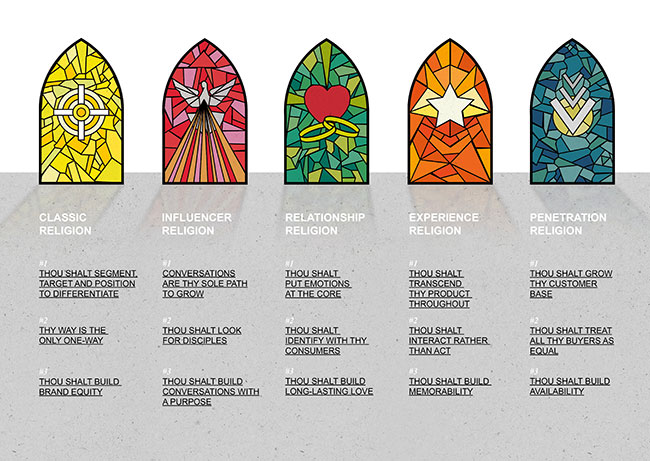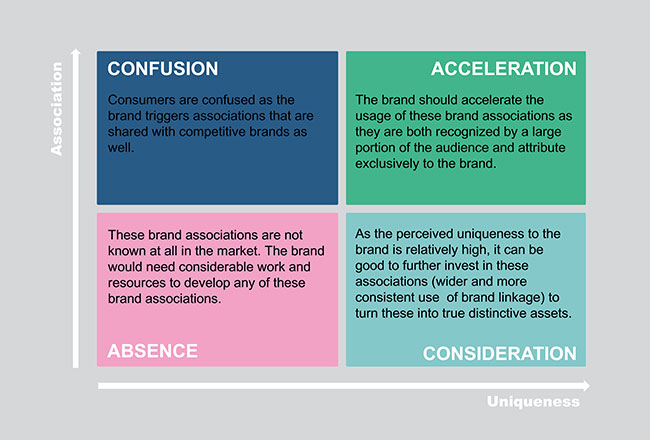Reasons to believe
Editor's note: Niels Schillewaert is co-founder of research firm InSites Consulting. Angie Deceuninck is managing director at InSites Consulting US.
 No two brands are the same. They have different objectives, serve different needs, are in different stages of their product life cycle, face different levels of competitive intensity and are run by different marketers with their own strategies. So why is it that we measure them the same way? Why do market researchers have the tendency to push standardized research approaches across brands regardless of context?
No two brands are the same. They have different objectives, serve different needs, are in different stages of their product life cycle, face different levels of competitive intensity and are run by different marketers with their own strategies. So why is it that we measure them the same way? Why do market researchers have the tendency to push standardized research approaches across brands regardless of context?
Branding research – as varied as segmentation and positioning, brand archetypes, distinctive assets, advertising optimization and testing, packaging research and brand tracking – is aimed at measuring brand success and performance. Yet what defines brand success and how can you measure it?
Every marketer needs to build, craft and grow strong brands. Many books have been written capturing marketing theories, frameworks and models on how to build future-proof brands. They provide brand owners and marketers with a framework on what defines brand success, which drivers to pursue as well as which key dimensions drive brand growth. Furthermore, they give insight into which metrics and KPIs to consider when measuring brand strength. This abundance of visions and beliefs causes a lot of confusion amongst brand owners and marketers on which strategy to pursue and how to define brand success. Yet in this abundance of complex choice, focus is crucial.
This is where the notion of religions kicks in. Religions have emerged because people want to have an explanation for phenomena that cannot be explained or are very complex. A religion is a line of thinking and “a pursuit followed with great devotion.” Similarly, as this definition points at, brands can benefit from choosing a brand strategy framework to guide them in everything they do.
In that sense brands need commandments (e.g., to gain understanding and alignment on brand strategy as well as measure brand foundations to support knowledge and instruction). Marketers and insight professionals need to contemplate (e.g., to develop your brand and translate it into brand activation, communication and packaging). And they need to show devotion – to consistently behave according to the commandments and track the performance of the brand and measure the impact of the marketing mix.
Those who have taken a course in marketing were probably introduced to Philip Kotler’s principles of marketing and branding. For those who have not, Kotler talks about STP (segmentation, targeting and positioning), the importance of differentiation and the creation of a unique selling proposition. Kotler is the godfather of modern marketing and he and other thinkers like Kevin Lane Keller and David Aaker have laid the foundation of what we could label as the classic religion. Just like the classics in food and music, this thinking is still of great value today, with many brands using it as a framework to set up their marketing plans or brand strategies.
Yet in the postmodern world this Kotlerian thinking is being challenged by new beliefs and visions of how to grow a brand. This has mainly happened due to consumers being more informed and knowledgeable, often empowered by technology and social media. There have also been new vogues in business and marketing theories by several thought leaders, e.g., around System 1 and System 2 thinking. According to some of these experts, brands need to stop segmenting and focus on the entire market to guarantee growth, while others appraise the empowered role of consumers where they become the voice of the brand. We found that we can bundle these various streams of thought in five brand religions.
The classic religion
“There is only one winning strategy. It is to carefully define the target market and direct a superior offering to that target market.” – Philip Kotler
The foundation of modern marketing, emphasizing the importance of segmenting the market and differentiating a brand in the minds of consumers. Building brand equity through the notion that retaining a customer is cheaper than acquiring a new one, backed by consistent integrated marketing communications, is at the core of this religion.
The penetration religion
”Sales growth won’t come from relentlessly targeting a particular segment of a brand’s buyers; this fantasy is harming marketing effectiveness.” – Byron Sharp
This school of thought challenges the classic thinking by introducing new marketing “laws” focusing on market penetration through acquisition of customers (not retention) based on mental and physical availability.
The relationship religion
“Emotion leads to action, while reason leads to conclusions.” – Donald Brian Calne, neurologist
This brand philosophy highlights the importance of building a long-lasting emotional connection with consumers to achieve loyalty from the heart and beyond reason, where these relationships are coherent with inter-human relationships.
The experience religion
“Welcome to a new era of marketing and service in which your brand is defined by those who experience it.” – Brian Solis, digital analyst, speaker and author
Building memorable experiences forms the foundations of this brand religion. Experiences surpass physical products consistently but also have exclusivity, play on multiple senses and focus on creating delight.
The influencer religion
“A brand is no longer what we tell the consumer it is; it is what consumers tell each other it is.” – Scott D. Cook
This brand religion follows a strategy of marketing “through” not “to” people. There is a key role for disciples (macro, micro or natural influencers) who generate online as well as offline word-of-mouth to create a ripple effect for growing the brand.

Each of these frameworks provides a different viewpoint on what defines brand success, what to aim for and which key performance indicators to pursue. The graphic summarizes the key principles or commandments, if you will, per religion.
While they all preach different beliefs, in the end, all brand religions serve the same purpose: growth in sales and creating shareholder value. As Mahatma Gandhi said: “The various religions are like different roads converging on the same point. What difference does it make if we follow a different route, provided we arrive at the same destination?”
What is important is that all stakeholders within a business align on which brand framework(s) to pursue and set off in the same direction. Regardless of the choice or mix, clarity is key as strategy is also choosing what not to do. A clear brand religion definition (or mix of religions) forces all stakeholders to act consistently, it clearly defines brand success and which key performance indicators and metrics to pursue to assess performance.
Outlines how one should measure
No two brands are the same, nor should they be measured the same way. The choice of brand religion (mix) not only shapes how one defines brand success, it also outlines how one should measure brand and communication performance. 
Consider advertising research, where many approaches focus on ad liking and recall. What defines a good advertisement depends on the brand strategy and thus the brand religion framework. A brand that follows the penetration religion will focus on creating ad messages that strengthen its “mental availability.” This school of thought emphasizes the importance of distinctive assets (i.e., brand identity elements like colors, slogans, logos, etc.) that signal the brand name to consumers and hence serve as memory shortcuts, allowing consumers to make buying decisions rapidly and easily. These assets allow a brand’s communication to work effectively. Brands should use these assets in communication (and packaging) consistently in order to build memory structures in the consumers’ minds over time. The research design should reflect this thinking and test if assets are strongly and uniquely associated to a brand – e.g., by means of putting participants under time or cognitive pressure.
Brands that pursue the relationship religion, on the other hand, will focus more on the emotions that are triggered by an ad. The relationship religion stipulates that ultimately consumers are driven by emotions and feel emotionally connected to brands. The goal of a brand is to build a brand-consumer relationship. Therefore, advertising here is aimed at building and strengthening that emotional connection with consumers. The research design will not focus on assets but rather on emotions by, for example, using an indirect measure like facial coding or an implicit association task to avoid rationalization.
A different research approach is also needed for brands pursuing the influencer religion strategy. Here the focus of the ad is to fuel conversations around brands, requiring research focus on the conversation potential of an ad. It is clear that, depending on one’s strategy, advertising has a different focus and therefore must also be measured differently.
The same can be said for trackers. Trackers serve as the ongoing finger on the pulse, gaining insight into how a brand is performing in line with brand strategy. However, trackers are probably one of the most static, repetitive and unidimensional research solutions out there. If one were to compare two random brand trackers, chances are they would be characterized by a similar research design and often be centered around measuring the brand funnel. This is a typical framework from the classic religion, which emphasizes that it all starts with building awareness, to then move to consideration, trial, usage, preference, ending with loyalty to build brand equity. While the classic thinking is still relevant today, we see many clients shift away from these principles, embracing new beliefs beyond the Kotlerian thinking.
If brands are shifting brand strategy frameworks, why are trackers still reflecting the classic marketing principles? Trackers should be seen as a composite of all metrics and KPIs that are important for brands to assess the extent to which they are on par with their brand strategy. Rather than considering a tracker as static and unidimensional, it should be a modular build-up where the KPIs reflect the relevant dimensions of brand success.
In essence, what one measures and how one measures it all link back to one’s brand strategy. All brands are different and brand success is defined differently. Before starting research, it is essential to understand what brand religion (or mix thereof) is right for your brand.
